A process flowchart is a graphical representation of a business process through a flowchart. It’s used as a means of getting a top-down understanding of how a process works, what steps it consists of, what events change outcomes, and so on.
How to Use This Guide
If you want to learn just about everything about process flowcharts, just read through the whole thing – we’ve got you covered. If you’re looking for specific sections, though, just jump over to whatever’s relevant!
What’s a Process Flowchart
A business process is a series of repeatable tasks your business needs to carry out in order to achieve some sort of business goal.
Flowcharts, on the other hand, are a means of visualizing the process.
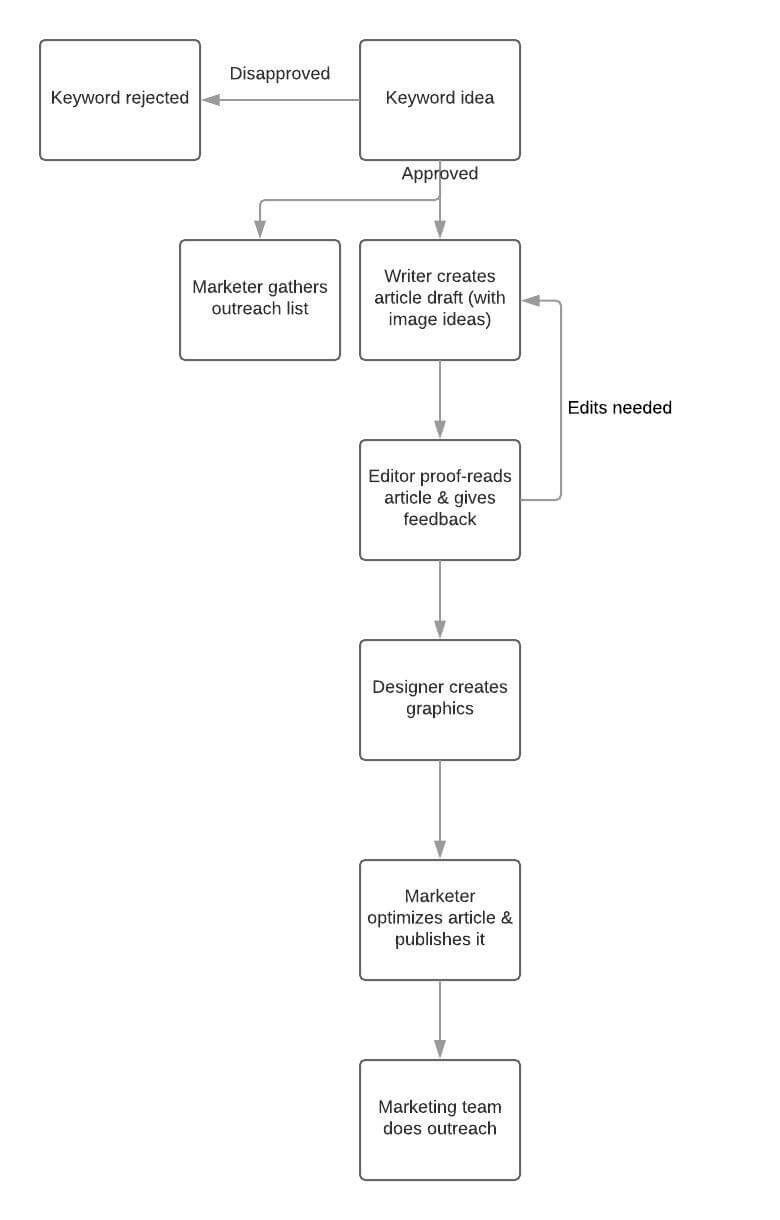
Process flowchart example: content marketing
Process flowcharts are an essential part of business process mapping. They help visualize your processes, making them significantly easier to fully comprehend.
Other than that, process flowcharts are usually used for…
- Understanding how a process works
- Improving the Process – Once you know how the process works, you can figure out potential improvements. You could, for example, remove or automate certain steps. You can even completely re-engineer the process and fundamentally change how it works.
- Standardizing a Process – Unless you’ve documented your processes, your employees will figure out different ways to carry it out. With a process flowchart, you can ensure that everyone’s on the same page about how the process should be done.
- Writing a Standard Operating Procedure – A process flowchart is just that – a flowchart. SOPs on the other hand, are a full documentation on how that process functions, how to carry it out, what tools or tech to use, and so on.
To really get the most out of your processes, you’d want to go for all of the options we just mentioned.
How to Draw a Process Flowchart in 3 Steps
At a glance, this sounds pretty simple – just about everyone can draw a flowchart.
Really making it accurate, though, isn’t all that simple. It’s one thing to look at the process from a management point of view; it’s another to actually understand what it consists of: the steps, methodologies, tools, and so on.
So, to draw a process flowchart, you should start with…
Step #1: Decide Whether You Need a Process Flowchart
Before you can even start learning about the process, you should make sure that a process flowchart is the right tool for the job.
If your aim is process analysis from a more top-level perspective, you might want to use other tools. While process flowcharts are perfect for detailing the step-by-steps of a process, they’re not as useful for gaining a deeper understanding.
SIPOC diagram, for example, analyses the entire process of product creation and delivery. It’s divided into 5 parts – suppliers, inputs, processes, outputs, customers.
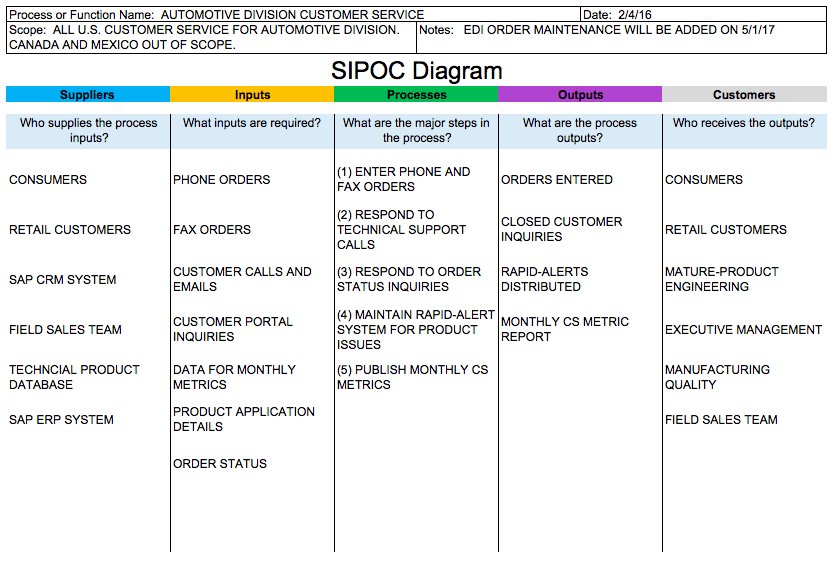
Step #2: Gather the Right Information
Unless you’re the one working on the process on a daily basis, you probably need to catch up on the details.
Even if the process seems simple or straightforward at a glance, there are a lot of small details that add up to it. You’d want to know, for example…
- What the exact process steps are
- Variables and events. In which situations do you deviate from a process
- Who’s in charge of what process step
So to really understand the inner workings of a process, consult shop floor employees. Set up a meeting and pick their brains. Who knows, maybe they’ll even have ideas on how to improve the process.
Step #3: Create the Process Flowchart
Once you have the information on how a process works, you can actually start drawing the flowchart.
If you want to keep it simple, you can use the basic process symbols…
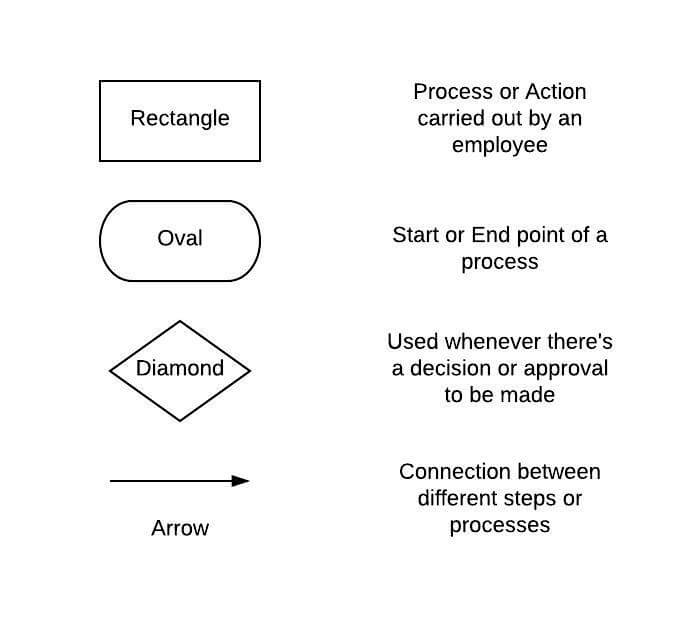
A better (but more complicated) option, though, would be to use BPMN2.
Business Process Modeling and Notation (BPMN) is a standardized methodology for documenting processes. Following the BPMN model makes it easier for your employees, management, as well as external consultants to understand the process map.
Whichever methodology you choose, you’ll then need to actually draw the flowchart. There are 3 ways to do this…
- Pen & Paper – The simplest option is to just grab a piece of paper, a pen and just draw the flowchart physically.
- Online Graphing Software – Chances are, you’re going to want the process flowchart to be digital. This makes it easier to make edits, share it with employees, and so on. To create an online flowchart, you can use a tool like LucidCharts.
- Business Process Management Software (BPMS) – While BPM software rarely helps create flowcharts, it does something even better. You can use BPMS to create digital processes, which you can either analyze or simply execute through the system. The software automates the process execution. Meaning, when a process step is completed, the next employee in line is automatically assigned the right task.
3 Process Flowchart Examples
You can create process flowcharts for just about any business process, whether it’s onboarding, sales, document approval, or anything in-between.
To give you a better idea of how these look, we’ll cover 3 examples of process flowcharts of different business processes.
Employee Onboarding Process
Just about every company ends up hiring new employees. Onboarding is an essential step in getting them up to speed & educating them on how the company or department functions.
Hence, it’s always a good idea to have a clear, structured process for this.
While the process varies from company to company, here’s a basic example…
- The HR gets the new employee to sign up the documents or legalities
- The documents go through an approval process between the HR and company management
- HR lets the company employees know about the new hire through email
- Office manager prepares all the necessary supplies or handouts
- Tech – software access, personal computer, etc.
- Welcome swag – Gifts, company t-shirt, etc.
- Onboarding materials
- Entrance ID
Or, as it would look in a process flowchart form…
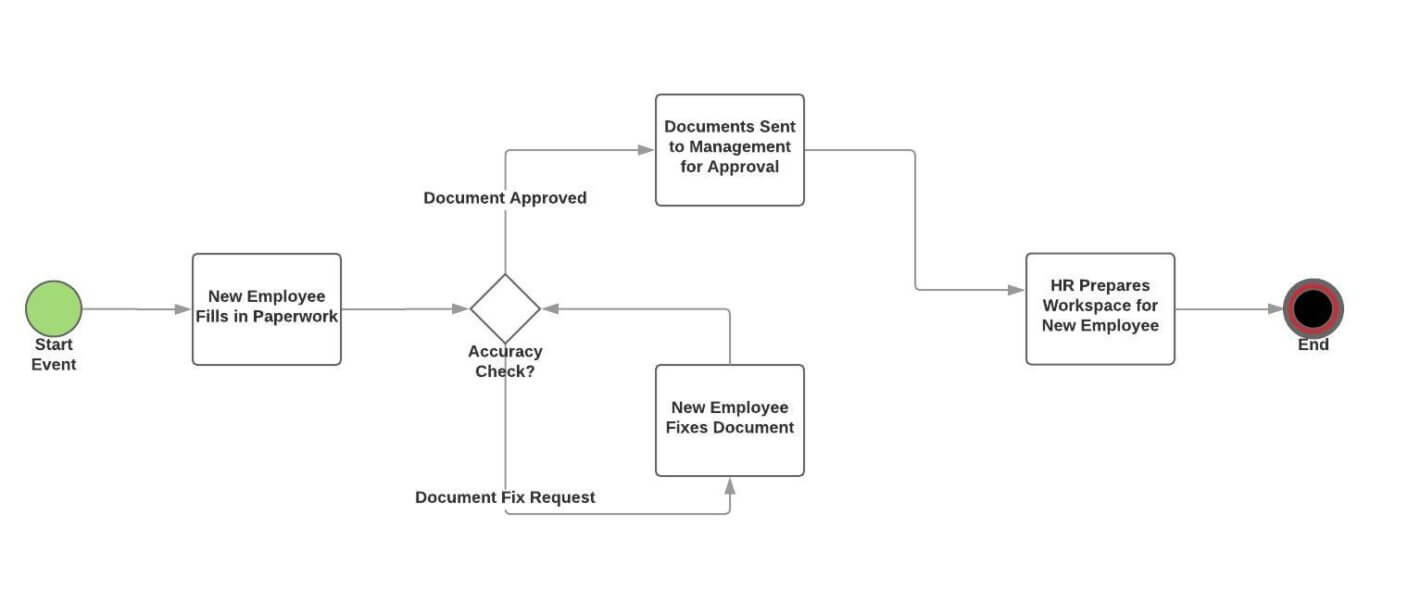
Document Approval Process
Getting all the right approvals for any document can be a major hassle. It involves a lot of emails back and forth, some of which end up getting lost or delayed. Having a procedure makes approvals significantly faster & more efficient.
The following is a basic document approval process, and it can apply to just about any type of document (legal, hr, etc.).
- The document is submitted
- If the document is disapproved, process canceled.
- If approved, the document is stored in a relevant folder
- Automatic email sent to any relevant party
Or, as it would look like in a flowchart…

To make this process even smoother, you can use approvals management software. Instead of having to shoot emails back and forth, you’d just start the process through Tallyfy & the system will make sure everyone’s signs at the right time.
Incident Response Process
Any company should have a contingency plan for potential incidents. While you can’t always predict what’s going to happen, you can have a strategy on how to react in such situations.
The following process flowchart example is for a cyber attack.
- The emergency is reported by a company employee after discovering an identified USB plugged into their computer
- The threat is evaluated by the security team. If false alarm, the process ends
- Emergency email sent to relevant company executives
- The company management and security team hold an emergency meeting
- The solution is proposed and applied
- If the solution didn’t work, the process rolls back to step 4. If it does, the process is completed
And of course, as a flowchart…
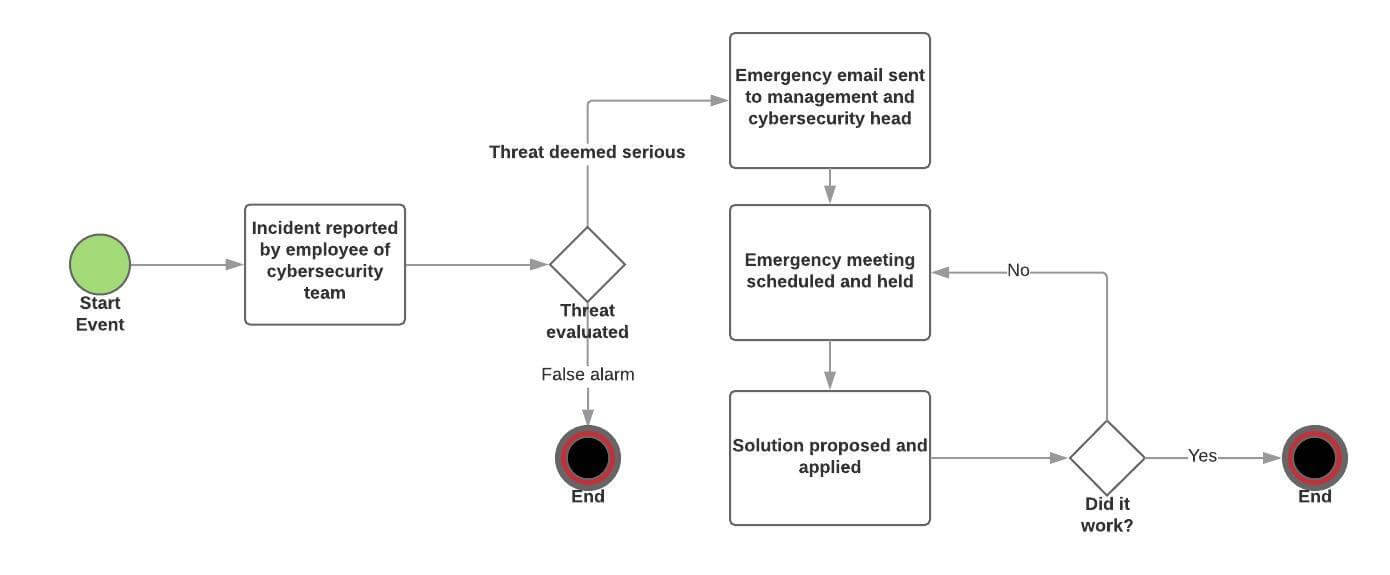
Process Flowcharts: An Essential Start to Business Process Management
Creating process flowcharts, while useful for introspection, is only a start.
You need to analyze the process, figure out potential improvements, implement them, and so on. After all, you really don’t get much by simply drawing the flowchart.
To learn how to do all this and more, check out our guide on Business Process Management. And no, it’s not just another buzzword-definition article – we’re going to explain how, exactly, BPM can help you optimizes your processes.
Related Questions
What is the process flowchart?
A process flowchart is the perfect way to demonstrate that how things get done. It’s like a map that you follow with shapes and arrows through each step of a process or project. Think about baking cookies — a sequence diagram is like a flowchart that would give you an image of the baking process, from ingredients to warm, gooey cookies. It’s a visual aid that clarifies intricate affairs at a glance.
What is process flow and example?
Process flow is defined as the route a quest follows from beginning to end. It’s akin to trailing a river from headwaters to the ocean. Consider, for example, ordering a pizza online. The operational flow could be something like this: You select your toppings, place an order, the restaurant receives the order, generates a pizza, a driver collects the pizza, and, after a short drive, delivers it to your door. Each step bleeds into the next, and that little path from hungry thought to happy meal is pretty smooth.
How do you write a flowchart for a process?
Making a flowchart is like telling a story using shapes. Begin with a ‘once upon a time’ oval. -Use rectangles for steps, diamonds for decisions that have to be made, and arrows to connect everything. Keep it simple — every shape should describe only one main idea. As you sketch, pretend that you’re teaching a friend how those illustrations came to be. You can use another oval when you get to your “happily ever after” ending. And as always, your flowchart should be so low friction that anyone can follow the story without getting lost.
What is the process flow diagram?
Think of what it shows as sort of peeking behind the curtain to see how things get done. More flowchart-esque, it is more frequently a high-level systems or industry diagram. Think of peering inside a chocolate factory – a diagram would reveal the stages that cocoa beans go through in becoming a tasty bar, with everything that goes in and out. It is a technically oriented cousin of the flowchart, used in the planning and analysis of complex operations by engineers, managers and process improvement professionals.
What are the 7 steps of a flowchart?
The 7 steps of making a flowchart feel almost like following a recipe for clarity. Step 1: First, collect your components, which will be the steps of the process you want to map out. Then, write down all the steps in sequence. 3rd, decide on your shapes: ovals for start and end, rectangles for actions, diamonds for decisions. 4) Next, organize these forms into an order. Fifth, draw arrows between the shapes to indicate flow. Sixth, put on any information or labels. Last, check and recheck your flowchart to ensure that it is simple to follow and correctly reflects the process. These, convert into a muddle of thoughts into a visual guide.
What are the 5 elements of a flowchart?
A flowchart’s five key components are its process, decision, direction of flow, a connector, and termination. First and foremost, you have symbols —- shapes that represent different kinds of acts or decisions. Beneath are lines and arrows indicating the direction and flow of the process. Third is text, the crisp, cool descriptors neatly packed inside each shape. Fourth is the order, the logical sequence of the steps. Finally, there is structure, how these pieces all tie together to tell the story of your process. It’s like an orchestra of elements playing together to create a harmonious visual allegory about how stuff works.

